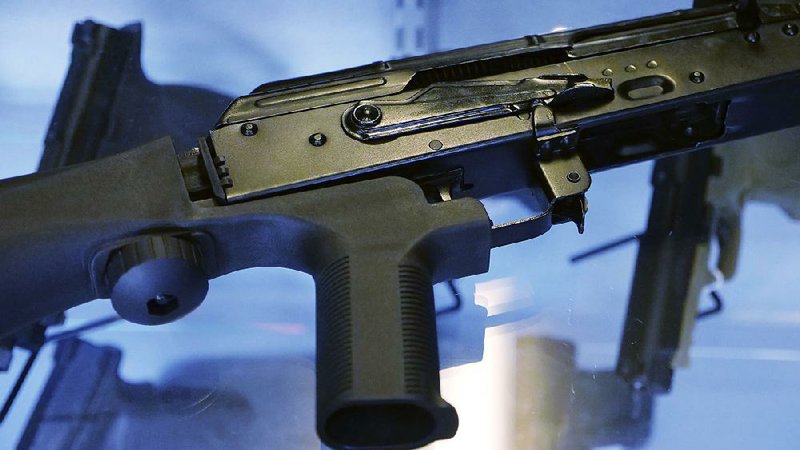WASHINGTON -- President Donald Trump's administration on Tuesday issued a new rule banning bump stocks, the attachments that enable semi-automatic rifles to fire in sustained, rapid bursts and that a gunman used to kill 58 people and wound hundreds of others at a Las Vegas concert in October 2017.
The new regulation, which had been expected, will ban the sale or possession of the devices under a new interpretation of existing law. Americans who own bump stocks will be given 90 days to destroy their devices or to turn them in to the Bureau of Alcohol, Tobacco, Firearms and Explosives. The Justice Department said the bureau will post destruction instructions on its website.
Bump stocks work by harnessing a firearm's recoil energy to slide it back and forth to bump against a squeezed trigger, so that it keeps firing without any need for the shooter to pull the trigger again. The Justice Department said that this function transforms semi-automatic weapons into fully automatic machine guns, which Congress sharply restricted in 1986.
"With limited exceptions, the Gun Control Act, as amended, makes it unlawful for any person to transfer or possess a machine-gun unless it was lawfully possessed prior to the effective date of the statute," the new regulation states. "The bump stock type devices covered by this final rule were not in existence prior to the effective date of the statute, and therefore will be prohibited when this rule becomes effective."
A senior Justice Department official, briefing reporters about the new rule on condition of anonymity, said that it was believed that tens of thousands of bump stock devices are in circulation but that more exact figures are unavailable. The official said the department expected that most owners of the devices would comply with the new regulation and that the bureau would investigate and take legal action against those who violate it.
After publishing a proposed version of the rule earlier this year, the government received 119,264 comments in support of it and 66,182 expressing opposition to it, the Justice Department said.
The regulatory move may face a legal challenge. The Justice Department had initially decided that the executive branch lacked the authority to ban bump stocks on its own under existing gun-control laws, and that action in Congress -- where it is politically difficult to enact new gun-control legislation -- would be necessary to curb legal access to the devices.
But the department reinterpreted its legal authority and determined it could ban the devices as an executive action after Trump directed it to find a way to prohibit them earlier this year, after the mass shooting at Marjory Stoneman Douglas High School in Parkland, Fla. The gunman in that shooting, who killed 17 people and wounded 17 others, did not use a bump stock.
The amended rule was met almost immediately with resistance from gun-rights advocates, including Gun Owners of America, which said it would file a lawsuit against the Justice Department and the Bureau of Alcohol, Tobacco, Firearms and Explosives to protect gun owners from "unconstitutional regulations."
"These regulations implicate Second Amendment rights, and courts should be highly suspect when an agency changes its 'interpretation' of a statute in order to impair the exercise of enumerated constitutional rights," the organization's executive director, Erich Pratt, said.
The Justice Department official said the government will fight any legal challenge that may be brought.
The National Rifle Association called on the Justice Department to provide amnesty for gun owners who already have bump stocks.
"We are disappointed that this final rule fails to address the thousands of law-abiding Americans who relied on prior ATF determinations when lawfully acquiring these devices," said spokesman Jennifer Baker.
In the immediate aftermath of the Las Vegas massacre, the NRA supported a bureau review of bump stock devices, seemingly breaking with its usual practice of opposing any new restrictions on legal access to firearms. At the time, it said it "believes that devices designed to allow semi-automatic rifles to function like fully automatic rifles should be subject to additional regulations."
Information for this article was contributed by Charlie Savage of The New York Times and by Michael Balsamo and Lisa Marie Pane of The Associated Press.
A Section on 12/19/2018
